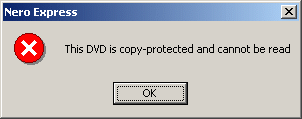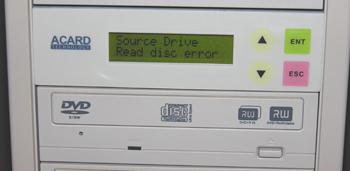Adding CSS Copy Protection to DVD
Introduction
CSS stands for Content Scrambling System. It is the copy protection scheme being used for DVD. The protection uses a relative week algorithm and it has long been cracked since 1996. Nevertheless CSS is still used by content owners who want to minimize the loss due to illegal DVD copying. The rationale is: If you cannot stop everyone, try to stop some ones.
DVD authoring software such as VideoStudio, and Apple Final Cut Pro all allow the enabling of CSS. But they also require the authored content be output to DLT tapes instead of DVD-R. Most DVD authors find this to be a frustrated nuisance as DLT tape drive is not a common peripheral on most computers.
This article briefly explains what CSS is, how it works, and the problems faced by DVD authors who want to add CSS to their DVDs. We then provide solutions to the problem by making it an authoring stage problem to be solved at the mastering stage.
How to add CSS to replicated DVD
There are two ways to add CSS; the complicated way (DMakers way) and the simple way (NewCyberian way).
Replicators runing the production lines by technicians who do not have enough knowledge on the file structure of a DVD will require you to enable the CSS flag in your authoring software and output the final result to a DLT tape. You will then send the DLT tape to the replicator. This is a very old way of adding CSS yet unfortunately is adopted by most replicators such as the notorious D**c Makers.
The simplier way is to send a DVD-R master to a replicator as if there is no need to add CSS. Knowledgable replicators run by engineers should be able to add CSS during the glass mastering stage. New Cyberian belongs to this second group of replicator. We can add CSS to an already authored DVD-R without the need for you to mess around with DLT tapes and the complicated settings within the authoring software.
CSS on DVD-R
There is a misconception that CSS can be added to a DVD-R or DVD+R. The fact is: CSS can only be added to replicated disc from glass master. The reason being the disc key is stored on tracks where DVD-R or DVD+R is not recordable, i.e. DVD writers cannot write information on those tracks. There are some strange ways of adding copy protection to DVD-R but they are either very expensive per copy or will potentially suffer from incompatibility issues with the DVD players. For example, one scheme is to intentionally damage certain tracks of the DVD-R in order to fool a DVD burner that the disc is damaged and should not be copied. DVD burners normally give up when they fail to read a sector of a DVD several times.
CSS in Action
The following pictures illustrate what happens when you try to copy a CSS protected DVD.

| If you try to copy a CSS protected DVD using a duplicator tower, the firmware of the duplicator tower will detect the CSS information and refuse the copying as well. The pictures below show what is displayed on an ACard and Smarrcopy control cards. | ||
 |
 |
|
CSS - A butt of all the jokes
Besides the Clinton Sex Scandal (CSS), Content Scrambling System has been a laughing stock since its release and later cracked by a 16 year-old kid in Norway. CSS uses a very simple encryption algorithm that revolves among three keys; i.e. the player key, the disc key, and the title key. The idea is: Every DVD player in the world is assigned with a unique player key. For example, a Sony DVD player will have a Sony key, an HP player will have an HP key. When a DVD is encrypted with CSS, the lead-in area of the disc will have maximum 409 encrypted keys and one of them will work with the player key to retrieve the disk key. Once the disc key is found, the player key is used again with the disc key to find the title key. The title key is the final key to decrypt the scrambled digital content.
In case you don't know what the keys are all about, they are analogous to a physical key which allow you to open the door and get access to the content behind the door. With a key you can unlock the secrecy and make the content clear and legible.
Glossary
CSS
Content Scrambling System
DeCSS
A computer program capable of decrypting content on a DVD video disc encrypted using the Content-Scrambling System (CSS)
Disc Key
The key to decrypt title keys on DVD discs
DLT
Digital Linear Tape
Duplicator
A stacking up of CD/DVD writers to form a tower that can copy multiple discs in one batch.
Encryption
A way to obscure information to make it unreadable without special knowledge, sometimes referred to as scrambling.
Nero
A popular disc copying software on desktop and laptop computers.
Player Key
The key to decrypt disc keys on DVD disc
Replicator
A company that can press CD/DVD using glass master.
Title Key
The key to scramble and descramble actual data on DVD discs called titles. A title could be a complete motion picture, a trailer or similar self-contained unit.